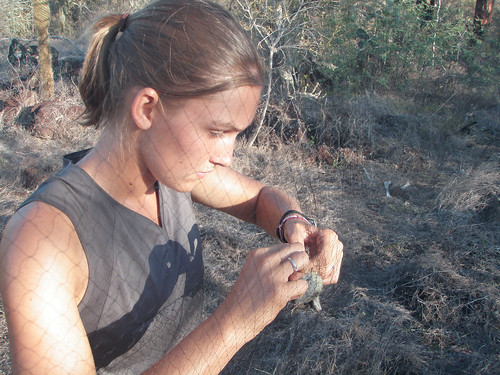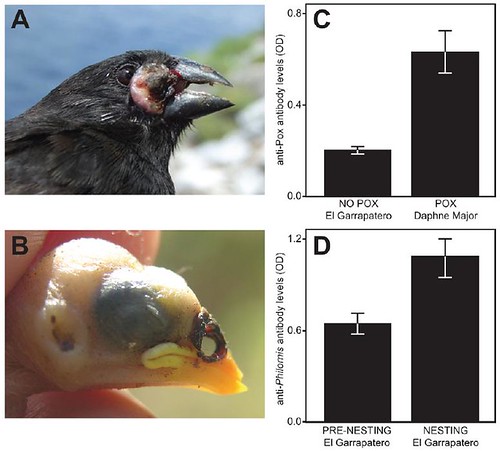tags: evolutionary biology, immunology, immune response, antibodies, parasite, avian pox virus, Poxvirus avium, nest fly, Philornis downsi, birds, ornithology, Darwin's Finches, Medium Ground Finch, Geospiza fortis, Ecuador, Galapagos Islands, researchblogging.org,peer-reviewed research, peer-reviewed paper
A male Medium Ground Finch, Geospiza fortis, sits on a tree branch in Ecuador's Galapagos Islands.
Image: Jen Koop.
People often view the Hawaiian islands as a tropical paradise, the ideal vacation site, but you wouldn't agree with this assessment if you happen to be a bird. According to a federal report published last year in the United States, nearly all of Hawaii's birds are in danger of becoming extinct due to habitat destruction, competition from imported species and of course, infections by alien disease organisms. In short, this tropical paradise is an ecological disaster area.
But the state of Hawaii's avifauna is not unique. Everywhere, island bird populations are being decimated, particularly those species that are endemic to the islands in the South Pacific Ocean. But interestingly, there is one island group where the ravages of avian extinctions has not yet occurred: the Galapagos.
The Galapagos is "the most famous group of islands that hasn't had any native birds go extinct yet," asserts University of Utah biology Professor Dale Clayton. "Many of the native species in Hawaii, for example, have gone extinct because of humans," who destroy habitat, hunt birds for feathers and introduce numerous predators such as cats, rats and pigs as well as mosquitoes carrying malaria.
Native birds have not yet gone extinct in the Galapagos because "there were few people living there until the mid-1800s," Professor Clayton points out. But that may change due to the introduction of South American nest flies, Philornis downsi, and of mosquitoes that carry the avian pox virus, Poxvirus avium.
Since island bird species -- including the famous Darwin's Finches of the Galapagos -- evolved in the absence of most parasites, they lack the ability to fight off these organisms. Or do they? With the appearance of these new parasites, will Galapagos birdlife soon be devastated, just like Hawaiian birds?
Maybe not, according to research conducted by Professor Clayton, Jen Koop, a University of Utah doctoral candidate, and the study's lead author, Sarah Huber, a former University of Utah postdoctoral researcher who now is an assistant professor at Randolph-Macon College in Virginia. They studied one species of Darwin's finches, the Medium Ground Finch, Geospiza fortis, and found that the birds are capable of mounting an effective immune response to two parasites that recently invaded the islands, despite lacking an evolutionary association with either of them.
The study primarily focused on the nest fly, which invaded the Galapagos around 1964. Scientists working on the Galapagos barely noticed these invasive flies until the 1990s when large numbers of their larvae were discovered in the nests of Galapagos land birds, including those of Darwin's Finches. Nest Fly larvae are parasites that feed on the blood and tissues of unfeathered nestlings, slowing their growth and even killing them (Figure 1B).
The team also studied the birds' immune response to the pox virus. Ms. Koop says this virus "creates lesions on non-feathered parts of a bird -- around the bill, eyes, legs and feet. Toes and feet can fall off." (Figure 1A)
To carry out this study, the researchers captured Medium Ground Finches on two Galapagos islands that are roughly 5 miles apart: Daphne Major and at El Garrapatero on Santa Cruz.
University of Utah biologist Jen Koop removes a Medium Ground Finch from a mist net in the Galapagos Islands off Ecuador. The birds were marked with a unique combination of colored leg bands prior to release to aid identification of individuals from a distance.
Image: Sarah Huber.
After examining the birds and their nests, the research team found nest flies on both islands, while pox virus was found only on Daphne Major.
To test the captured birds' immune response, the team collected a small blood sample from a wing vein prior to release. Study coauthors Marisa King and Jeb Owen developed and optimized a special enzyme-linked immunosorbent assay (ELISA) to check the finches' blood for antibodies against the pox virus and nest fly antigens (data not shown).
Basically, ELISA tests are a biochemical technique primarily used by immunologists to quickly detect the presence of a particular antibody or an antigen in a sample, and to determine the amount of these proteins that are present. These assays are very sensitive.
"This study develops a tool that can be used to survey the rest of the Galapagos to determine which populations of birds have been exposed to the parasites and which have not been exposed," says Professor Clayton. "The tool could be used to see if birds on some islands are better than birds on others at fending off the parasites."
These data revealed two things: first, finches on Daphne Major mounted an immune response to pox virus that was three times stronger than that of the Santa Cruz finches (Figure 1C), which showed no signs of the virus. Second, nesting finches on Santa Cruz had an antibody response to nest flies that was 1.7 times stronger than the response shown by birds tested prior to nesting (Figure 1D).
Figure 1. Parasite-specific antibody response of Geospiza fortis. (A) Medium ground finch, Geospiza fortis, with pox lesion in front of eye. (B) G. fortis nestling with Philornis downsi lesions in nostrils and ear. (C) Pox-binding antibody levels of adult birds on Daphne Major (n = 30) were higher than those of adult birds at El Garrapatero (n = 113) (Mann Whitney U = 619.50, p < 0.0001). (D) Philornis-binding antibody levels of adult birds with active nests at El Garrapatero (n = 37) were higher than those of adult birds prior to nesting (n = 76) at the same site (U = 800, p,0.0001). Antibody response is measured as the optical density (OD) at 450nm. Bars indicate mean±standard error.
doi:10.1371/journal.pone.0008605.g001
While these data are interesting, especially to conservation biologists, I think it would be useful to identify whether there are measurable species differences in the speed for mounting an immune response to a novel parasite. Do Galapagos finches mount an immune response more quickly than do Hawaiian birds? Do Galapagos finches mount a more effective immune response than do Hawaiian birds? If so, this could help explain the dramatic loss of indigenous Hawaiian avifauna, and may be useful for identifying other isolated populations that may be lost to extinction due to a slow or ineffective immune response.
Of course, as an evolutionary biologist, I am interested in this scenario as another example of the evolutionary arms race. This rather descriptive term is used to describe the evolutionary struggle between competing groups of co-evolving genes that develop adaptations and counter-adaptations against each other, resembling an arms race. These "arms races" frequently reach a dynamic equilibrium, an always shifting balance, between competitors. But species that have not competed against each other for long periods of evolutionary time do not have any such balance of power. We know that when isolated species, such as Hawaiian avifauna, have not been subject to an arms race previously, they can be at a severe disadvantage and become extinct before adapting to a new predator, competitor, or parasite.
There is a long history of humans introducing invasive species into new locations throughout the world, and easily affordable international air travel and ecotourism will only serve to increase this disturbing trend.
Which leads me to puzzle over the evolutionary history of the Galapagos finches as compared to that of the Hawaiian avifauna -- if Galapagos finches demonstrate a more vigorous immune response to alien parasites than do Hawaiian birds, might distinct evolutionary histories partially explain the dramatic differences in extinction rates? At this point, further research is necessary to decipher the patterns that may exist and to use that information to identify populations at greatest risk for extinction so biologists and policy-makers can develop more effective conservation programs to preserve them.
Source:
Huber, S., Owen, J., Koop, J., King, M., Grant, P., Grant, B., & Clayton, D. (2010). Ecoimmunity in Darwin's Finches: Invasive Parasites Trigger Acquired Immunity in the Medium Ground Finch (Geospiza fortis) PLoS ONE, 5 (1) DOI: 10.1371/journal.pone.0008605




This is really interesting and obviously great news, especially for Galapagos finches. Thanks for presenting the research.